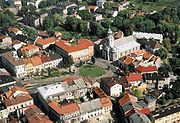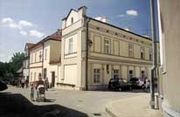Wadowice
From Wikipedia, the free encyclopedia.
| Wadowice | |||||
|
|||||
| Motto: none | |||||
 |
|||||
|---|---|---|---|---|---|
| Voivodship | Lesser Poland | ||||
| Municipal government | Rada Miasta w Wadowicach | ||||
| Mayor | Ewa Filipiak | ||||
| Area | km² | ||||
| Population - city - urban - density |
19.500 (2001) none /km² |
||||
| Founded City rights |
10th century? 1430 |
||||
| Latitude Longitude |
49°53' N 19°30' E |
||||
| Area code | +48 33 | ||||
| Car plates | KWA 01XX | ||||
| Twin towns | |||||
| Municipal Website | |||||
Wadowice is a town in southern Poland, 50km from Krakow with 19,500 inhabitants (2001), situated on the Skawa river, confluence of Vistula, in the eastern part of Silesian Plateau (Pogórze Ślaskie). Wadowice is famous as the birthplace of Pope John Paul II (1920).
Contents |
History
The first permanent settlement in the area of today's Wadowice was founded in late 10th century or early 11th century. According to a local legend, the town was founded by certain Wad or Wład, a short form for the Slavic name of Ladislaus. The town is first mentioned as Wadowicze in St. Peter penny register in years 1325-1327. In 1327 it is also mentioned (under the same name) in a fief registry sent from prince John I Scholastyk of Oświęcim to Bohemian king John I, Count of Luxemburg. At this time it was a trading settlement belonging to the Dukes of Silesia of the Piast Dynasty, and according to some historians it was already a municipality. In 1430 a great fire destroyed the town. It was soon rebuilt and granted city rights, along with a city charter and a self-government, based on the then-popular Chełmno Law. The privileges, granted by Prince Kazimierz I of Oświęcim led to a period of fast reconstruction and growth.
The administrative division of the region in the times of regional division was complicated. Initially, between 1313/1317 and 1445, Wadowice belonged to the Silesian Duchy of Oświęcim and after 1445 to the Duchy of Zator. In 1482 Władysław I of Zator inherited only half of his father's lands and created a separate Duchy of Wadowice, which lasted until his death in 1493. The following year his brother and successor, Jan V of Zator abdicated. At the same time the land was subject to Bohemian overlordship, which lasted until the following year, when the Duchy was bought by the Kings of Poland and incorporated as a Silesian County. Finally, the County was incorporated into the Kraków Voivodship in 1564.
In the 16th-17th centuries Wadowice was a regional centre of crafts and trade. Among the most notable sons of the town was Marcin Wadowita, a teologist, philosopher and a deacon of the Kraków Academy. He was also the founder of a hospital and a basic school in Wadowice. However, several plagues and fires halted the prosperity and the town's growth was eventually halted as well.
In the effect of the 1st Partition of Poland, Wadowice was annexed by Austria and incorporated into the newly-established Kingdom of Galicia, under direct Austrian rule. The town's growth started soon afterwards, after a road linking Vienna with Lwów was built. The town became a seat of a communal administration and since 1867 - a county site. Small industries were developing slowly during the 19th century. New inhabitants settled in the area, attracted by the industry, new military barracks and various administrative institutions. In addition, a new hospital and a regional court were erected in the town centre. Finally, in the last 25 years of the 19th century partial liberalisation of the Austro-Hungarian monarchy led to creation of various Polish cultural and scientific societies.
After the World War I and the dissolution of the monarchy, Wadowice became part of the newly-reborn Poland. The seat of a powiat remained in the town and in 1919 the inhabitants of the area formed the 12th Infantry Regiment that took part in the Polish-Bolshevik War of 1919-1920. In 1920 Karol Wojtyła was born in Wadowice (later known as the bishop of Kraków and Pope John Paul II).
After the Polish Defence War of 1939, Germany occupied the area and on October 26 Wadowice was annexed to the Third Reich. On December 29 of the same year the town was renamed to Frauenstadt. Initially the Polish intelligentsia was targeted by harsh German racial and cultural policies and hundreds of people from the area, most notably priests, teachers and artists, were murdered in mass executions. Hundreds more were expulsed and resettled to the General Government in order to make place for German settlers. Between 1941 and 1943 a ghetto was established in the city. Almost entire local Jewish population (more than 2.000) was exterminated, mostly in the nearby Auschwitz concentration camp. In addition, the Germans set up a POW camp for Allied soldiers and a penal camp that served as a transfer camp for various German concentration camps. Despite German terror, the Home Army units were active in the area, most notably in the town itself and in the Beskid mountains to the south of it.
After the war, in 1945 Wadowice retained its powiat town status and until 1975 served as a notable centre of commerce and transport in the Kraków Voivodship. After that the town was transferred to the newly-created Bielsko-Biała Voivodship. After the peaceful transformation of the political and economical system in Poland (in 1989), most of the local industry was found inefficient and went bankrupt. However, the ecological and historical heritage of the area, as well as the place being the birthplace of Pope John Paul II, led to a fast growth of tourist potential. Currently there are more than 200.000 people coming to Wadowice every year and this number is going higher with every year.
Economy
Wadowice is today mainly a centre for tourism and sightseeing, but also a place for small industries like machines production, food processing and production of construction materials.
Culture and Sightseeing
- Days of Wadowice (Dni Wadowic) are held every May-June. The feats starts every May 18 to commemorate the birth of Karol Wojtyła
- Museum of the Holy Father Family House in the native home of Pope John Paul II collects remainders and relics about Karol Wojtyła and his family.
- Parochial church - the Virgin Mary's Offertory Minor Basilica - 15th century, rebuilt in 18th century
- Kościelna 4 street, an 18th century house
- Classicist "Mikołaj" manor - 19th century, named after mayor Mikołaj Komorowski
- Municipal Museum of Marcin Wadowita
- Pope John Paul II square with 19th century burgher houses
- Monument to Emil Zegadłowicz, a writer who described the area of Wadowice in many of his books
Notable people
- Marcin Wadowita Martinus Vadovius Campinus (born 1567), Polish teologist, philosopher and deacon of the Kraków Academy
- Emil Lask (b. 1875), philosopher
- Berta Lask (b. 1878), writer
- Ada Sari (Jadwiga Schayer, b. 1886) opera singer and actress
- Godwin Brumowski (born 1889), Austro-Hungarian WWI fighter ace and air general
- Karol Wojtyła (1920-2005), Polish priest and bishop of Kraków, 1978-2005 the Roman Catholic Pope (as John Paul II)
- Rafał Bujnowski (b. 1974), painter
External links
- Wadowice Town Council
- http://www.it.wadowice.pl - Tourist Information
- http://www.wck.wadowice.pl/ - Wadowice Cultural Center
- http://www.wadowice.pl/dom/srodek.htm Pope's home
- http://www.wadowice-online.com/ - Wadowice Online Guide
- http://www.wadowice.com/ - info. Wadowice
Sports
- http://www.skawa.iap.pl/ - Klub Sportowy Skawa Wadowice, football club
- http://pukskarol.pl - football, basketball, voleyball and swimming
Business
- http://www.skawa.com.pl/ - ZPC Skawa Wadowice, sweets producer
- http://www.fumis-bumar.com.pl/ - Fumis-Bumar, producer of mechanical devices
- http://www.maspex.pl/ - Maspex Wadowice, producer of drinks and juices
- http://www.ponar-wadowice.pl/ - Ponar Wadowice, producer of hydraulics devices
- http://www.ajb.pl/ distributor of electrical products and bearings






